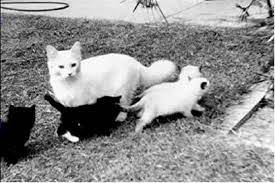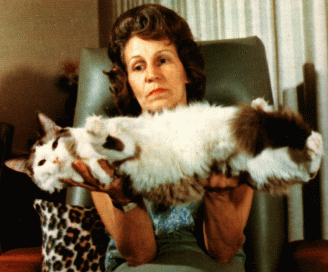Ragdoll Cat History
The history of the Ragdoll cat breed is a fascinating tale of accidental discoveries, selective breeding, controversies, and the efforts of dedicated breeders to establish and refine a distinctive and beloved feline breed. While there are various accounts of the breed's origins, the following provides a more detailed overview of the Ragdoll's history:
Early Beginnings: Josephine and the Origins
The Ragdoll breed's story is often attributed to a white Persian-like cat named Josephine. In the early 1960s, Josephine was allegedly injured in a traffic accident, leading to behavioral changes. She reportedly became extremely docile, limp, and affectionate, even when handled. Ann Baker, a woman living in Riverside, California, claimed to be Josephine's owner and began a breeding program using Josephine and other cats.
According to Ann Baker's account, Josephine's kittens exhibited her unique temperament traits, such as going limp when picked up, which gave rise to the name "Ragdoll." Ann Baker's version of the breed's origin suggests that the breed's unique traits were the result of a genetic mutation caused by Josephine's accident.
Selective Breeding and Controversies
Ann Baker began selectively breeding Ragdoll cats, using Josephine's offspring and other cats from the area. She claimed to have crossbred Josephine with Burmese, Birman, and Persian cats, among others. Baker introduced the term "Ragdoll" and established the International Ragdoll Cat Association (IRCA) to register and promote the breed. She also coined the term "Ragdoll genealogy" to describe the breed's unique genetics.
Baker's approach to breeding Ragdolls was marked by secrecy and proprietary practices. She required Ragdoll breeders to sign contracts giving her sole rights to the breed and charging fees for using her breeding lines. These practices led to tensions and disagreements within the Ragdoll breeding community.
Emergence of Ragdoll Fanciers Club International (RFCI)
Amid growing dissatisfaction with Ann Baker's control and practices, a group of Ragdoll breeders led by Denny Dayton formed the Ragdoll Fanciers Club International (RFCI) in 1971. The RFCI aimed to promote the breed and establish standards that would be free from Baker's influence.
The RFCI worked to distance the breed from Baker's controversial claims and practices. They developed breed standards based on the appearance and temperament traits that had become synonymous with Ragdoll cats. These standards outlined specific coat patterns, colors, eye colors, and other desirable qualities.
Recognition and Standardization
The efforts of the RFCI and other independent Ragdoll breeders gradually gained recognition from major cat registries like The International Cat Association (TICA) and the Cat Fanciers' Association (CFA). These organizations established official breed standards that emphasized the Ragdoll's gentle nature, striking blue eyes, and color-pointed coat patterns.
Over the decades, breeders continued to work on refining and expanding the Ragdoll breed. They focused on improving coat quality, strengthening the breed's genetic diversity, and ensuring that the cats adhered to the established standards.
Modern Ragdoll Cats
Today, the Ragdoll breed is known for its large size, semi-longhair coat, captivating blue eyes, and gentle personality. Ragdolls are often described as being exceptionally affectionate, loyal, and sociable, forming strong bonds with their human companions.
While the Ragdoll's origins remain somewhat shrouded in controversy and conflicting accounts, the dedication of Ragdoll enthusiasts and breeders has solidified its position as a beloved and recognized breed in the world of domestic cats.
Persian Cat History
The history of Persian cats is rich and fascinating, dating back thousands of years. These luxurious, longhaired felines have captivated people with their exquisite appearance and calm demeanor. Here's an overview of the history of Persian cats:
Ancient Origins:
The origins of Persian cats can be traced to ancient Persia (modern-day Iran) and surrounding regions. These cats are believed to have been bred selectively for their unique coat, and they were highly regarded by nobility and aristocracy in Persia.
Travel and Trade:
Persian cats' beauty and desirability led to their spread across various parts of the world. Phoenician traders are thought to have introduced these cats to ancient Egypt, where they became prized pets. Persian cats are even depicted in ancient Egyptian art and hieroglyphics.
Arrival in Europe:
Persian cats found their way to Europe through trade routes and diplomatic exchanges, becoming a symbol of luxury and refinement. They gained favor among European nobility and royalty, particularly in France and England.
Selective Breeding and Modernization:
In the late 19th and early 20th centuries, cat fanciers in Europe and North America began to formalize the breeding and standardization of Persian cats. They selectively bred for specific coat colors, patterns, and facial features. The breed's appearance gradually evolved to the familiar round face, short muzzle, and large, expressive eyes.
Challenges and Rejuvenation:
During the mid-20th century, the Persian breed faced challenges due to excessive inbreeding and health issues associated with extreme facial features. Efforts were made to address these concerns, and breeders worked to restore the breed's health and vitality.
Variations and Divisions:
Over time, distinct variations of Persian cats emerged, such as the Himalayan Persian (also known as Colorpoint Persian), characterized by its colorpoint coat pattern reminiscent of the Siamese breed.
Modern Persian Cats:
Today, Persian cats remain beloved companions and are known for their elegant appearance and gentle temperament. They come in a wide range of coat colors and patterns, including solid, tabby, bicolor, and more. Their luxurious coats require regular grooming to prevent matting and maintain their beauty.
Breed Characteristics:
Persian cats are known for their distinct physical features, including:
Round face with a short muzzle.
Large, round, and expressive eyes.
Small, snub nose.
Plush, longhaired coat.
Cultural Impact:
Persian cats have left an indelible mark on popular culture. They have been featured in literature, art, and even film and television. Additionally, their presence on social media and their status as beloved pets have contributed to their continued popularity.
In conclusion, the history of Persian cats spans millennia, encompassing ancient civilizations, trade routes, and the refinement of a breed that has captured the hearts of people worldwide. Today, Persian cats remain cherished companions known for their stunning appearance and gentle personalities.
Birman Cat History
The history of Birman cats is steeped in legend and mystique, making it a captivating tale of spirituality, devotion, and the origins of a unique and beautiful feline breed. While the exact details of the Birman's early history are a blend of fact and myth, the breed's journey from its ancient Burmese origins to its recognition as a distinct breed is a fascinating story:
Ancient Origins:
The Birman cat's origins can be traced back to ancient Burma (modern-day Myanmar) and the temples of Burma's sacred city of Lao-Tsun. According to legend, Birmans were temple cats who lived alongside Burmese priests and were considered sacred companions to the temple's priests and high-ranking members.
The Legend of the Goddess Tsun-Kyan-Kse:
The most well-known legend surrounding the Birman breed is that of the goddess Tsun-Kyan-Kse. According to the story, the temple's high priest possessed a highly revered golden statue of Tsun-Kyan-Kse. One day, the temple was attacked by marauders, and the priest was killed while defending the statue. As he died, his loyal cat, a Birman named Sinh, is said to have leapt onto the statue and gazed into its eyes.
As Sinh gazed upon the statue, his white coat transformed into a golden hue, his eyes turned blue like the statue's, and his paws remained white as a symbol of the purity of the temple. The legend suggests that the souls of the priests were carried into the bodies of the Birmans, imbuing them with spiritual significance.
Introduction to the Western World:
The Birman breed's presence in the Western world began in the early 20th century. In 1919, a pair of Birmans named Malden Lilac and Malden Blue were brought to France by a pair of Frenchmen returning from Burma. These cats became the foundation for the breed's development in Europe.
Recognition and Breed Development:
Birman cats were further developed and established as a breed in France and Europe through selective breeding. Efforts were made to preserve the breed's distinctive appearance, including its striking blue eyes, colorpoint coat, and white-gloved paws.
Formal Recognition:
The Birman breed was recognized by cat registries in Europe and the United States in the mid-20th century. The breed's development was formalized, and breed standards were established to maintain the Birman's unique characteristics.
Breed Characteristics:
Birman cats are known for their distinctive features:
Colorpoint coat pattern with darker points on the ears, face, paws, and tail.
Vivid blue eyes that contribute to their captivating and expressive gaze.
Medium to long, silky coat that lies close to the body.
White-gloved paws, where the feet are a contrasting color to the rest of the point color.
Today, Birman cats are cherished companions around the world, admired for their beauty, gentle nature, and enchanting history. While the legends surrounding the breed's origins remain shrouded in mystery, the Birman's spiritual aura and allure continue to captivate cat lovers and enthusiasts.
Burmese Cat History
The Burmese cat is a breed with a fascinating history that dates back several centuries. Here's a brief overview of the history of Burmese cats:
Ancient Origins: While the exact origin of Burmese cats is unclear, they are believed to have originated in Southeast Asia, specifically in Burma (now Myanmar), Thailand, and neighboring regions. They were considered sacred and were often associated with temples and religious practices.
Introduction to the West: Burmese cats were introduced to the Western world in the late 1800s and early 1900s. In the 1930s, a pair of Burmese cats named Wong Mau and Tai Mau were brought to the United States by Dr. Joseph Thompson. Wong Mau, in particular, became the foundation cat for the breed in the West.
Breeding and Recognition: The initial Burmese cats brought to the West were darker in color and had a more compact body shape compared to the modern Burmese breed. Over time, selective breeding efforts focused on refining the breed's appearance while retaining its charming personality.
Color Divisions: In the early days, Burmese cats were primarily known for their sable (dark brown) coat color. However, breeders later introduced a variety of coat colors, including champagne (light beige), blue (gray), and platinum (pale silver). These color variations eventually led to the division of Burmese cats into two main categories: traditional Burmese (sable) and contemporary Burmese (other colors).
Recognition and Standardization: Burmese cats gained recognition from various cat breeding associations and organizations over the years. The breed standards were established to define the ideal appearance and characteristics of Burmese cats, taking into account factors like coat color, body shape, eye color, and personality traits.
Characteristics and Personality: Burmese cats are known for their affectionate and people-oriented nature. They tend to form strong bonds with their human companions and often enjoy being lap cats. They are also playful and intelligent, making them popular choices as indoor pets.
Health and Care: Like all breeds, Burmese cats have specific health considerations, including dental issues, respiratory problems, and certain genetic conditions. Responsible breeding practices aim to minimize these health risks. Regular veterinary care, a balanced diet, and a comfortable living environment contribute to their overall well-being.
Popularity and Spread: Burmese cats have gained a steady following over the years due to their charming personality and distinctive appearance. They are appreciated by cat enthusiasts around the world and are commonly found as cherished pets in many households.
In summary, the history of Burmese cats is one of cultural significance, gradual refinement through selective breeding, and a journey from their origins in Southeast Asia to becoming beloved companions in various parts of the world. Their unique charm and endearing qualities continue to capture the hearts of cat lovers everywhere.


